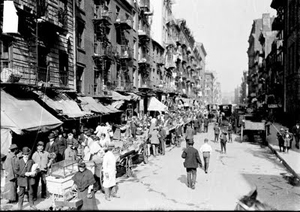
The Arts Desk: Dan Snow's toxic trilogy climaxed in New York, where he crawled voyeuristically through the rotten core of the Big Apple. It was part Discovery Channel documentary, part Gangs of New York dirty realism, as Snow took a frankly indecent relish in regaling us with tales of death, disease and raw capitalism at its baby-eating worst.

In the event, studying the development of America's greatest city from the bottom up, as it were, made perfect sense. In the mid-19th century, New York was a crude frontier settlement that occupied merely the southernmost tip of Manhattan island. Immigrants, for example the 650,000 Irish who were fleeing the potato famine back home, were dumped into stinking tenements run by fat-cat bosses and slum landlords who bullied and robbed them.
Lack of plumbing, sewers or running water meant it was open season for typhus and cholera, and the poor huddled masses played host to an interesting variety of wildlife including bedbugs and disease-carrying lice. The streets were littered with dead cats, rotting horses and excrement, while freely grazing pigs were the nearest thing to a street-cleaning service. Taxpayers' money was being embezzled by bent politicians like William "Boss" Tweed. Of course, some say 21st-century Wall Street isn't much better (New York's Lower East Side, 1910, pictured below).

A larger than average CGI budget allowed Snow to juxtapose himself with tattered wretches from the century before last, and on one occasion three Dan Snows occupied a single tenement room, to illustrate the concept of overcrowding. New York's evolution from satanic swamp, where butchers sold customers rotting meat cured with borax and clothing dye, to thrusting turbo-metropolis was signposted by key technological developments which transformed the city, then rippled out across the industrialized world. Having been poorly lit by noxious coal gas, New York became a sparkling new wonderland thanks to Thomas Edison and his amazing electric light, though Edison's Direct Current was speedily supplanted by Nikola Tesla's longer-range Alternating Current. Despicably, Edison tried to sow doubt about AC by using it to kill Topsy, the Coney Island elephant, preserving the animal's demise on film.

A filthy New York City street in 1893.
Meanwhile, running water was brought to New York by damming the Croton River and building a spectacular aqueduct to carry the water 40 miles to the city, though at first only the uptown rich could afford it. The downtown drones continued to flounder in a sea of merde. All this water needed somewhere to overflow into, so the city found itself equipped, perforce, with a spiffing new sewage system. Meanwhile New York was still surrounded on all sides by water heaving with untreated sewage, which was being pumped nonchalantly into the East and Hudson rivers. Before you could say "bada-bing!", huge sewage treatment plans sprang up, and Richard H Gould introduced the British invention of "activated sludge" which used bacteria to purify the water.

Filthy Cities - Industrial New York
Hi,
ReplyDeleteI am very glad to inform you this blog is very useful for those who want to know the get information about maid service for cleaning the house, garden. I find here good information about maid service as I were looking last so many times.
.
Thanks & regards
Johnmatin
This comment has been removed by a blog administrator.
ReplyDelete